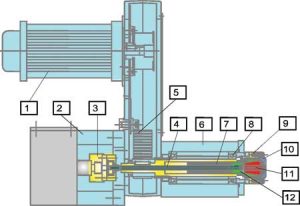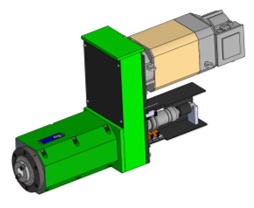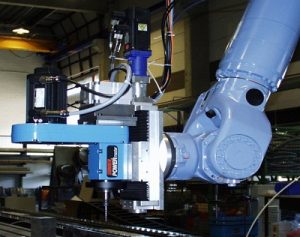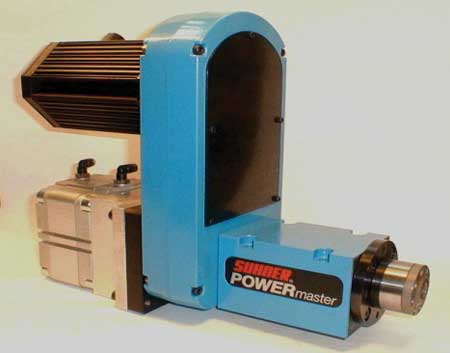More and more often, machining units are used with strong arm robots in drilling, milling, deburring, grinding or brushing operations.
SUHNER now has a spindle-program specifically made to use with robots; designed to meet demanding application requirements.
Manufacturing cells with robots typically work in a fully automatic mode, requiring automatic tool changes as well.
SUHNER offers 3 types of machining units. Selection ties to drilling performance for mild steel. Models BEX15 WW-ER25 and BEX 15 WW-HSK32 cover up to Ø15mm. Maximum permissible torque values, depending on unit configuration, range between 12Nm and 50Nm. Model MAX 40-CO offers 400 Nm maximum torque, reaching a drilling capacity of Ø 40mm in mild steel.
BEX 15 WW – ER 25
This model includes a specially-designed clamping system. Tool clamping is achieved with ER collets size ER16 or ER25. Collet (Pos. 11) is inside a pressure ring (Pos. 12.) Clamping occurs as the disc-spring-loaded drawbar (Pos. 4) pushes the pressure ring into the spanner ring (Pos. 10). An inline, short-stroke cylinder (Pos. 2) opens the clamp. This type clamping system transmits up to 12Nm of torque.
 This clamping system is ideal for tools with a cylindrical shaft and best applied in grinding and wire brush operations (illustrated in picture). Here, the BEX 15 WW is tooled with abrasive flap-wheels to clean a welding seam. The machining unit can pick-up a new tool from a linear tool magazine located to the rear. In order to control wear and usage, the abrasive tool is measured after each grinding cycle. This information is fed back to the robot control system to make adjustments or to initiate a tool change.
This clamping system is ideal for tools with a cylindrical shaft and best applied in grinding and wire brush operations (illustrated in picture). Here, the BEX 15 WW is tooled with abrasive flap-wheels to clean a welding seam. The machining unit can pick-up a new tool from a linear tool magazine located to the rear. In order to control wear and usage, the abrasive tool is measured after each grinding cycle. This information is fed back to the robot control system to make adjustments or to initiate a tool change.
Another application is placement of rivet holes on aircraft parts. Feed motion is done with a CNC-controlled slide to achieve required accuracy. The robot is used primarly for positioning.
The key advantage of a collet-type tool-holder and clamping system is that exact spindle orientation is never a requirement. This allows the use of standard AC-motors; servo motor is not necessary.
 BEX 15 WW – HSK 32
BEX 15 WW – HSK 32
This special unit uses a standard BEX 15 machining unit combined with a HSK 32 Superloc clamping system from Roehm. The clamping system is a self-locking design; eliminating the need for a disc-spring package. The HSK clamping system opens and closes using an activation rod. An inline short-stroke, pneumatic-cylinder with end position control opens and closes the tool clamping mechanism.
With this design, a complete tool change includes both the HSK 32 tool holder and the tool. This allows pre-setting the tools outside of the machine — a critical requirement for high-precision manufacturing operations.
The application of tool-clamping systems according to HSK form A and form C requires spindle-orientation features with servo motor drives. Maximum torque is limited to 55Nm.
AC-motor-drive options without spindle orientation use an HSK form E. Maximim torque is limited to 16Nm.
BEX 15 WW-HSK32 with a Superloc clamping system can be used for coolant-through-spindle applications.
 MAX 40 CO
MAX 40 CO
The largest machining unit for use in robot applications is the MAX 40 CO. This unit comes equipped with an ISO 40 or an optional HSK 63 spindle. Coolant-through-spindle is possible for both tool-holder options. Clamping and tool retention are accomplished by a spring-loaded drawbar assembly. Tool release is done with a pneumatic cylinder. Disc-spring package including a special tool-gripper system with an included mechanical ratio can develop a tool retention force up to 12kN. Process capability can be monitored using 4 proximity switches controlling the following functions:
• Tool clamped
• Tool released
• Home position w/o tool
• Home position w/o tool and no rotation (Tool change position)
Best choice for a spindle-drive on a MAX 40 CO is a servo motor as automatic tool-change requires a defined-spindle orientation point.
Up to 400Nm torque at the spindle allows for some serious drilling and milling operations. This also demands a strong robot as illustrated in the picture. Clamped workpieces of alloy steel can be milled completely and followed by a drilling operation of Ø21mm diameter.



















